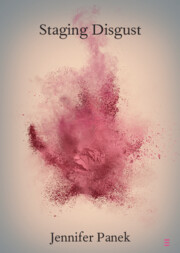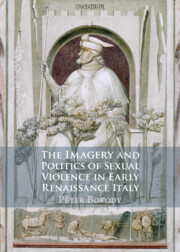119 results
11 - Sex in Geneva in the Sixteenth Century
-
-
- Book:
- The Cambridge World History of Sexualities
- Published online:
- 26 April 2024
- Print publication:
- 16 May 2024, pp 210-231
-
- Chapter
- Export citation
3 - Sexuality in the Systems of Thought and Belief of the Ancient Near East
-
-
- Book:
- The Cambridge World History of Sexualities
- Published online:
- 26 April 2024
- Print publication:
- 16 May 2024, pp 43-62
-
- Chapter
- Export citation
10 - The Impact of the World Wars on Modern Sexuality
-
-
- Book:
- The Cambridge World History of Sexualities
- Published online:
- 26 April 2024
- Print publication:
- 16 May 2024, pp 204-226
-
- Chapter
- Export citation
16 - Sexual Violence in History
-
-
- Book:
- The Cambridge World History of Sexualities
- Published online:
- 26 April 2024
- Print publication:
- 16 May 2024, pp 339-361
-
- Chapter
- Export citation
18 - Post-Colonialism and Sexuality
-
-
- Book:
- The Cambridge World History of Sexualities
- Published online:
- 26 April 2024
- Print publication:
- 16 May 2024, pp 388-410
-
- Chapter
- Export citation
Chapter 7 - Yahweh Who Watches a King (2 Samuel 11:1–24:25)
-
- Book:
- The Theology of the Book of Samuel
- Published online:
- 08 May 2024
- Print publication:
- 09 May 2024, pp 178-213
-
- Chapter
- Export citation
Chapter 33 - Suicide
- from Part V - Culture and Society
-
-
- Book:
- Pirandello in Context
- Published online:
- 14 March 2024
- Print publication:
- 21 March 2024, pp 266-272
-
- Chapter
- Export citation
6 - Loathsome Sympathy
-
-
- Book:
- Percy Shelley for Our Times
- Published online:
- 07 March 2024
- Print publication:
- 14 March 2024, pp 133-155
-
- Chapter
- Export citation

Staging Disgust
- Rape, Shame, and Performance in Shakespeare and Middleton
-
- Published online:
- 05 February 2024
- Print publication:
- 29 February 2024
-
- Element
- Export citation
My Body Is My Temple? Comparing Sexual Crimes and Property Crimes in a Human Rights Tradition – ERRATUM
-
- Journal:
- German Law Journal / Volume 25 / Issue 1 / February 2024
- Published online by Cambridge University Press:
- 26 January 2024, p. 152
-
- Article
-
- You have access
- Open access
- HTML
- Export citation
Chapter 14 - Political Thought
-
-
- Book:
- The Cambridge Critical Guide to Latin Literature
- Published online:
- 04 January 2024
- Print publication:
- 18 January 2024, pp 753-816
-
- Chapter
- Export citation
My Body Is My Temple? Comparing Sexual Crimes and Property Crimes in a Human Rights Tradition
-
- Journal:
- German Law Journal / Volume 25 / Issue 1 / February 2024
- Published online by Cambridge University Press:
- 15 January 2024, pp. 1-16
-
- Article
-
- You have access
- Open access
- HTML
- Export citation
Chapter 3 - Invasions of Interiority
-
- Book:
- Faulkner's Cartographies of Consciousness
- Published online:
- 02 November 2023
- Print publication:
- 16 November 2023, pp 73-108
-
- Chapter
- Export citation
Chapter 5 - “I Was Gone Again”
-
-
- Book:
- The Cambridge Companion to F. Scott Fitzgerald
- Published online:
- 26 October 2023
- Print publication:
- 09 November 2023, pp 106-124
-
- Chapter
- Export citation
Introduction
-
- Book:
- Good Soldiers Don't Rape
- Published online:
- 11 August 2023
- Print publication:
- 06 July 2023, pp 1-17
-
- Chapter
- Export citation
8 - Conclusion
-
- Book:
- Good Soldiers Don't Rape
- Published online:
- 11 August 2023
- Print publication:
- 06 July 2023, pp 151-154
-
- Chapter
- Export citation

Good Soldiers Don't Rape
- The Stories We Tell About Military Sexual Violence
-
- Published online:
- 11 August 2023
- Print publication:
- 06 July 2023
Rape in early China: two case studies
-
- Journal:
- Bulletin of the School of Oriental and African Studies / Volume 86 / Issue 2 / June 2023
- Published online by Cambridge University Press:
- 06 September 2023, pp. 277-291
- Print publication:
- June 2023
-
- Article
-
- You have access
- Open access
- HTML
- Export citation
Prison of the Womb: Gender, Incarceration, and Capitalism on the Gold Coast of West Africa, c. 1500–1957
-
- Journal:
- Comparative Studies in Society and History / Volume 65 / Issue 2 / April 2023
- Published online by Cambridge University Press:
- 19 January 2023, pp. 296-320
-
- Article
-
- You have access
- Open access
- HTML
- Export citation

The Imagery and Politics of Sexual Violence in Early Renaissance Italy
-
- Published online:
- 13 January 2023
- Print publication:
- 26 January 2023



